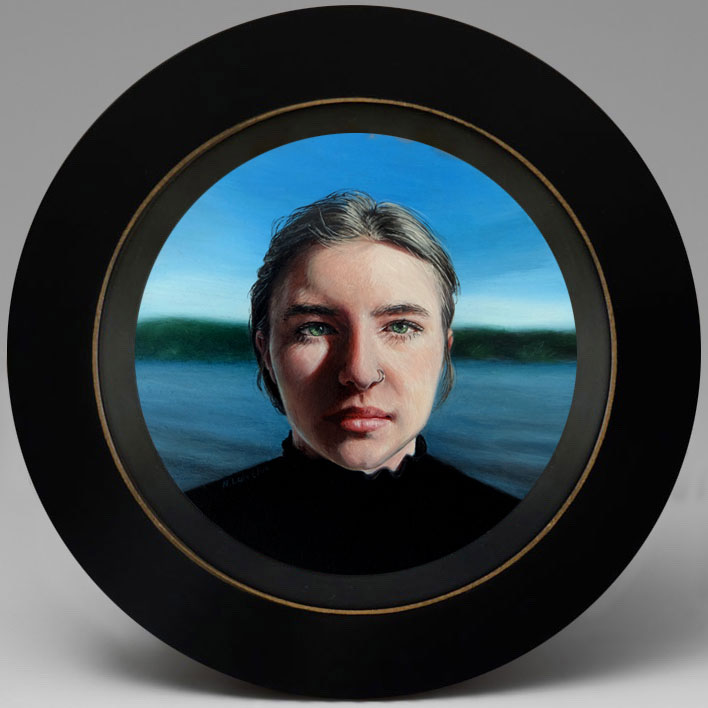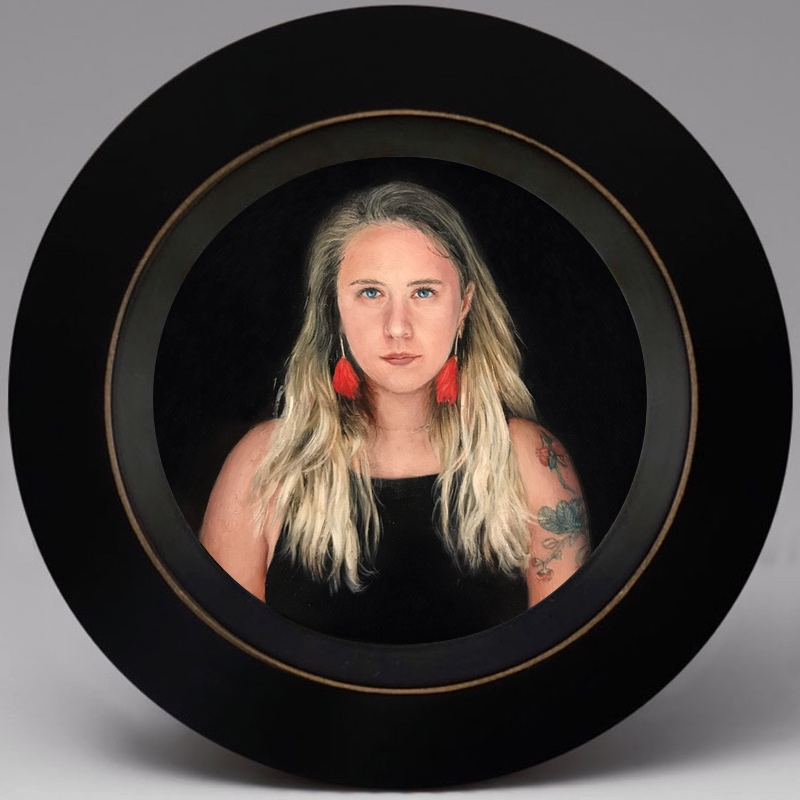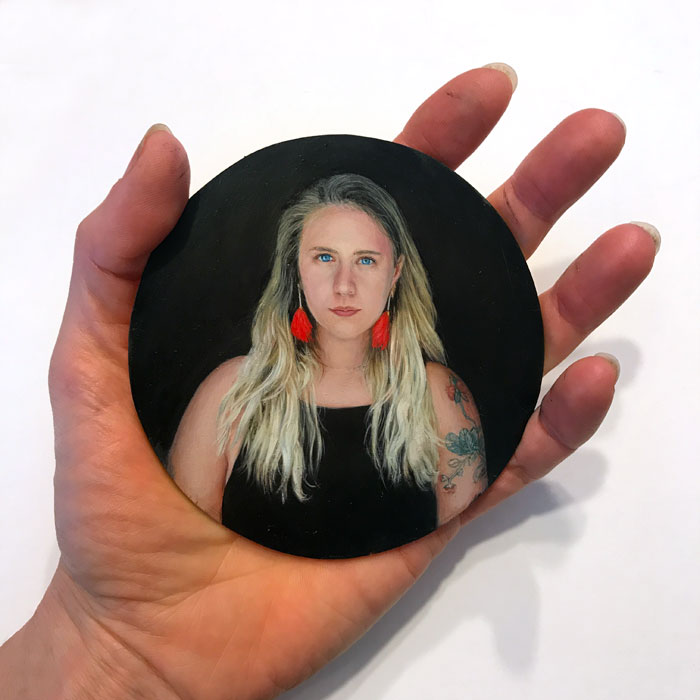Childern of artists, Miniature Portrait
Tim Marsden used to say my dog Buster made him want to have a dog. His daughter Olwyn, the subject of this months miniature portrait, is the kind of kid who makes you want to have a kid, like the opposite of birth control.
When I first met the Marsdens at Seattle’s SOIL Gallery, Olwyn was still in a stroller. Tim and I became friends and soon hatched the plan to start Artnight. We met like clockwork to make art, each Thursday night for 14 years, and Artnight grew to over a dozen artists.
It’s hard to fully express how meaningful that time was for me, to work in a studio full of artists, inspired by the driven people creating all around. I was privileged to watch artists mature, develop themes in their work, and perfect their craft.
Since moving north years ago, Artnight is my greatest loss. This is so hard to write. Until now, I have not realized how much I have missed my friend. While this series is about artists inspiring me to take up the challenge of parenthood, of all the artists participating, none has inspired me more than Tim.
I love spending time with Tim and Sandy. They are a warm and loving couple, and it just feels great to be around them. Tim loves nothing more than telling a funny story to a room full of people, and Sandy is Tim’s straight man. But nobody makes Tim laugh more than Sandy.
Whenever Artnight got together at Tim’s studio, Olwyn joined the group to work on her own projects. Even then, Olwyn was like a little adult to me. I don’t talk about my friends Tim and Sandy and their daughter, but rather my friends Tim, Sandy and Olwyn. Now suddenly my little Olwyn is all grown up and going to college. I don’t know how Tim and Sandy are managing it.
Olwyn is confident and headstrong and knows her mind. She is also funny, insightful and warm. I have painted the whole family over the years (including their late dog Nippy), and this is my second painting of Olwyn. See all my paintings of the Marsden’s in my previous post.
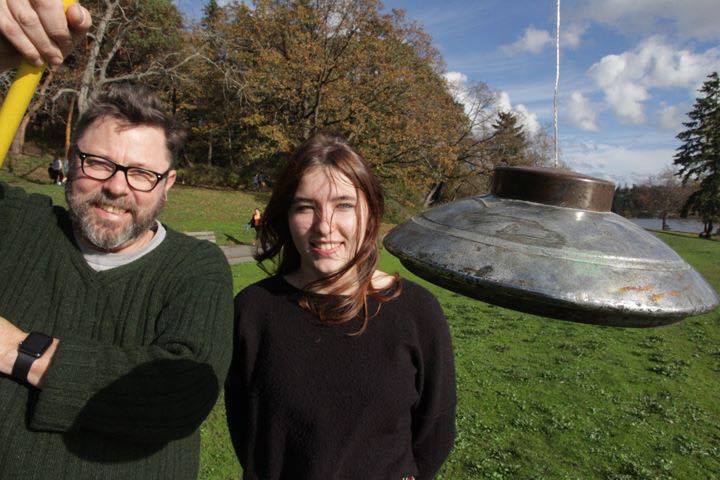
Olwyn and Tim playing with artist, Christian French’s UFO (photo Christian French)
Olwyn and Tim playing with artist, Christian French’s UFO.
From Tim:
After Olwyn was born both Sandy and I both worked part time (I was working a little less than part time, more like infrequent time) until Sandy returned to a more typical schedule. We are both happy we did. The front loading of time with your kid is best done right away and I am sure it helped with the strength of bond we all feel as a family. At the time I was renting studio space from the Two Bells, a small shop front right on 4th Avenue. Olwyn would be in a playpen we had set up in the studio and we would put serious miles on the stroller, running errands and just generally getting overstimulated until Sandy came home. The studio was right next to the apartment as well so everything was within striking distance. Apart from a fairly short stint of having a studio in a factory under the West Seattle bridge I have always had the good fortune to have my studio in the house. While there are a few restrictions borne of such a situation, the pros far outweigh the cons. It also means there is art hanging around all the time which I am certain has had a massive hand in Olwyn’s attitude to the Arts and also in how she navigates the world.
Olwyn’s presence rarely, if ever, interfered with with making art. There was no censorship for young innocent eyes, no closed door policy and she was always encouraged to work on her own projects or give me a hand stretching canvas as well as other studio practices. Having to work another job interfered far more with the making of work than having a child. Actually, the Art Museum was a pretty good place to work when Olwyn was younger and sometimes she would join me in the storage areas and write down accession numbers of pieces in the collection. Olwyn has strong memories of the Museum storage right up to the point that she was no longer welcome.
Much like if you are raised by wolves, you are not afraid of wolves, so it is with artists and their offspring. Olwyn is neither intimidated by or afraid of art. She sees it for what it is, an exploration of our world through a variety of different means- some more than successful than others executed by human beings as best they can. Warts and all we are all just people…making stuff.
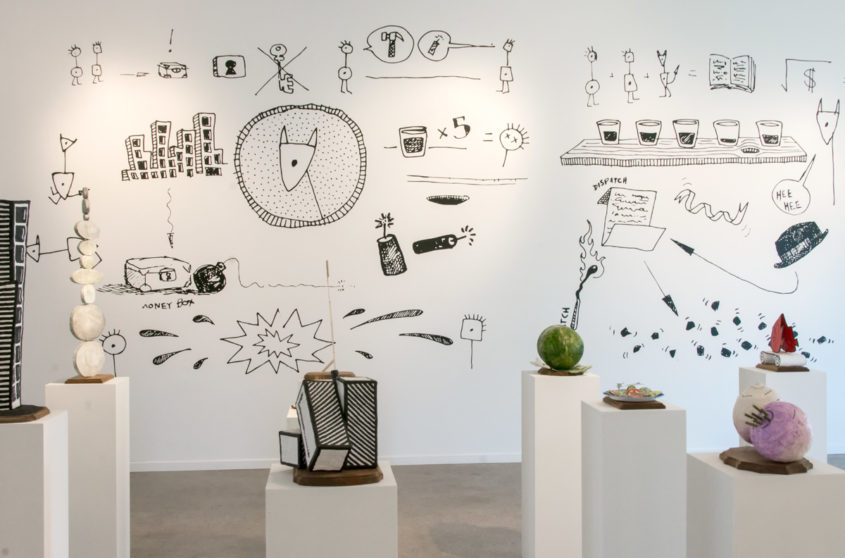
“Short Stories” exhibit at Studio E Gallery (Photo: James Arzente)
Tim Marsden has been a practicing artist for over 30 years. In that time he has shown work internationally but has been based in Seattle since moving from Europe in 1997. Primarily trained as a painter, Marsden’s work has expanded to embrace a number of different media, including but not limited to, sculpture, drawing and animation (film). Marsden’s interest in narrative has been a major influence on his work and he uses storytelling in a variety of different ways to explore the foibles and absurdities humans are subject to.
His most recent show entitled “Short Stories” was an installation composed of a number of stand-alone pieces (each composed of a number of stand-alone pieces) in order to create an overall composition in the exhibition space. Artistic influences are far too numerous to mention, although Goya, Turner and the German Expressionists are ever-present ghosts at the feast. Outside of visual art Marsden is also influenced by literature (Notably Nikolai Gogol) and films, again most notably Ealing Comedies. Marsden is currently working on a body of work tentatively titled “Sardine vs. Anchovy, two books of recipes (one in collaboration with Chef Chavez from the eponymous restaurant) and an installation (show) imagining a personal world to which you are all invited.

